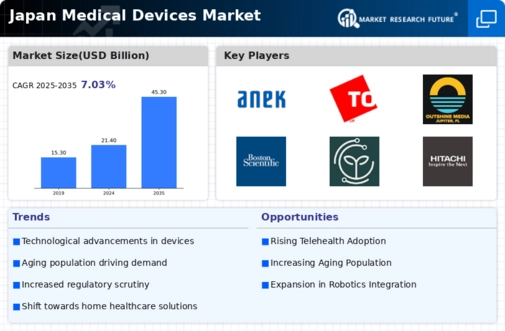Increased Investment in R&D
Investment in research and development (R&D) is a critical driver for the medical devices market in Japan. The country is known for its strong emphasis on innovation, with R&D spending in the healthcare sector reaching approximately $10 billion in 2025. This investment fosters the development of cutting-edge medical technologies, including minimally invasive surgical devices and advanced imaging systems. The medical devices market stands to gain from these advancements, as new products are introduced that meet the evolving needs of healthcare providers and patients. Moreover, collaboration between academic institutions and industry players enhances the innovation landscape, leading to the creation of novel medical devices that improve patient care. As R&D continues to thrive, the medical devices market is expected to expand, driven by the introduction of innovative solutions that address current healthcare challenges.
Rising Healthcare Expenditure
The medical devices market in Japan is experiencing growth driven by increasing healthcare expenditure. In recent years, Japan has seen a steady rise in healthcare spending, which reached approximately $500 billion in 2025. This increase is attributed to the government's commitment to improving healthcare services and infrastructure. As a result, hospitals and clinics are investing more in advanced medical devices to enhance patient care and treatment outcomes. The medical devices market benefits from this trend, as healthcare providers seek to adopt innovative technologies that can improve efficiency and effectiveness. Furthermore, the aging population in Japan necessitates higher spending on medical devices, particularly in areas such as diagnostics and monitoring equipment. This trend indicates a robust demand for medical devices, positioning the industry for sustained growth in the coming years.
Focus on Preventive Healthcare
The medical devices market in Japan is increasingly influenced by a shift towards preventive healthcare. This paradigm shift emphasizes early detection and management of health conditions, which is crucial in a country with a rapidly aging population. The Japanese government has initiated various programs aimed at promoting preventive measures, leading to a growing demand for diagnostic and monitoring devices. For instance, the market for wearable health technology is projected to grow by 15% annually, reflecting the rising consumer interest in health monitoring. This focus on preventive healthcare not only enhances patient outcomes but also reduces long-term healthcare costs, thereby benefiting the medical devices market. As healthcare providers and patients alike prioritize prevention, the demand for innovative medical devices that facilitate early diagnosis and continuous monitoring is likely to increase significantly.
Regulatory Support for Innovation
Regulatory support plays a pivotal role in shaping the medical devices market in Japan. The government has implemented policies aimed at streamlining the approval process for new medical technologies, thereby encouraging innovation. Recent reforms have reduced the time required for regulatory approvals, allowing companies to bring new products to market more quickly. This supportive regulatory environment is crucial for the medical devices market, as it fosters competition and drives technological advancements. Furthermore, the government is actively promoting initiatives that encourage collaboration between regulatory bodies and industry stakeholders, ensuring that new medical devices meet safety and efficacy standards. As a result, the medical devices market is likely to experience accelerated growth, driven by a continuous influx of innovative products that address the evolving needs of the healthcare sector.
Growing Demand for Home Healthcare Solutions
The medical devices market in Japan is witnessing a surge in demand for home healthcare solutions. This trend is largely driven by the aging population, which is increasingly seeking convenient and accessible healthcare options. Home healthcare devices, such as telehealth systems and portable monitoring equipment, are becoming essential for managing chronic conditions outside traditional clinical settings. The market for home healthcare devices is projected to grow by 20% over the next five years, reflecting the changing preferences of patients and healthcare providers. This shift not only alleviates pressure on healthcare facilities but also empowers patients to take control of their health. The medical devices market is well-positioned to capitalize on this trend, as manufacturers develop innovative solutions tailored to the needs of home care, ultimately enhancing patient outcomes and satisfaction.























Leave a Comment